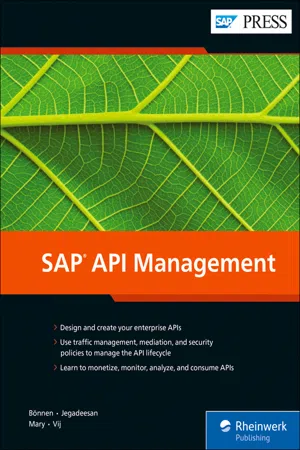1 Introduction
To begin our journey into application programming interfaces (APIs), we’ll start with the basics and explore why APIs are the building blocks of digital transformation. We’ll also introduce the important role that SAP API Management plays in the API economy.
It’s difficult to argue against the idea that software is taking over our daily lives—everything is going digital. Digital natives such as Uber, Airbnb, Netflix, and Alibaba are disrupting established industries, such as transportation, hospitality, entertainment, and retail, with no physical infrastructure and with only digital tools such as mobile apps and APIs. Digital transformation isn’t an isolated phenomenon for digital natives alone. For enterprises across industries, digital is a reality.
A digital enterprise engages customers across all touch points—both digital and physical—and provides personalized product recommendations. Customers configure cars, buy furniture for their apartments, and place orders through mobile apps or digital assistants such as Amazon Echo. Sometimes, intelligent devices such as refrigerators and coffee machines make their own refill orders. Raw materials are sourced from global suppliers through procurement business networks such as SAP Ariba. Order fulfilment and value additions are done by partners managing third-party warehouses. Orders are delivered by delivery services (e.g., Uber Rush) or through self-guided drones.
So how are targeted product recommendations provided to customers across all the channels—mobile, kiosks, call centers, and storefronts? How do the virtual reality environments know about product configuration information? How are orders taken into an ERP from digital assistants, how do we collaborate with third-party warehouses and delivery partners, and how do the drones know where to deliver? All these digital interactions happen outside traditional IT boundaries and environments and are facilitated by open APIs—the digital building blocks for enterprises.
What Are APIs?
APIs have been part of software development for a long time now. APIs define formal contracts to enable applications and services to communicate with each other.
APIs enable application-to-application (A2A) integration as well as application development; however, they have never been in the spotlight. Remote procedure calls (RPCs) and Win32 APIs have been around for decades. SAP’s own remote function calls (RFCs), business application programming interfaces (BAPIs), and IDocs have helped customers to extend and integrate with the SAP platform since the days of SAP R/3.
Modern web APIs are based on Internet principles using open protocols such as HTTP and JavaScript Object Notation (JSON). Today, if you’re building apps (mobile, SAP Fiori, or any other frontend technology) or integrating systems using middleware, you’re already using APIs.
APIs unlock enterprise data and processes for digital consumption and interactions while enabling businesses to share and exchange digital assets beyond conventional applications, websites, and devices. Given that APIs play a fundamental role in traditional processes, they need to be managed in a systematic manner.
SAP API Management is a full-lifecycle API platform that can help companies kick-start their enterprise API programs and achieve measurable business outcomes with a clear API strategy in a short time span. SAP API Management is part of SAP’s multicloud digital business platform—SAP Cloud Platform. Officially, SAP API Management is SAP Cloud Platform API Management. In this book, we’ll simply use SAP API Management, for consistency.
The purpose of this chapter is to provide an introduction to APIs. We’ll describe the new trends in enterprise and digital business, explain using use cases how APIs can support a digital business strategy, demonstrate why it’s important to manage enterprise APIs, and finally present a brief introduction to the SAP API Management platform. In doing so, we’ll see how it fits into SAP’s business technology platform to set the context for the rest of the book.
1.1 Trends in Digital Business
Digital businesses leverage modern technologies, such as big data analytics, mobile, artificial intelligence (AI)/machine learning, Internet of Things (IoT), and cloud platforms, to accelerate innovations, transform customer experiences, move to new business models, collaborate in real time with partners, and achieve end-to-end process excellence that cuts across organizational boundaries.
Enterprises are evolving into digital businesses by undergoing a massive digital transformation. Digital transformation has become an imperative for enterprises to lead the pack in their industries. In this section, we’ll explore some key emerging trends in the enterprise.
1.1.1 Emergence of the Intelligent Enterprise
Algorithms have had a huge influence on the way we live and work as a society. AI is making a strong comeback and will have even a stronger influence in the future. Many people still think of AI as science fiction, but AI is already becoming part of our daily lives, whether it’s Google Photos automatically identifying and classifying your friends and family or the email spam filters constantly learning and protecting us from spam emails by automatically classifying emails.
AI aspects such as machine learning, natural language processing, and computer vision are revolutionizing business processes across lines of business (LoBs) and industries. By deeply embedding intelligence into business processes in finance, manufacturing, logistics, and customer engagement, enterprises can revolutionize customer engagement, optimize and save costs across the value chain, and thereby improve operational efficiencies and margins.
An intelligent enterprise leverages intelligent technology, such as AI/machine learning/chatbots, IoT, and cloud platforms, to do the following:
- Recommend next-best actions in specific business situations
- Prioritize work for LoB employees, and automate simple and repetitive tasks
- Propose process improvements by uncovering patterns and insights
An intelligent enterprise transforms business data (operational data, machine data, and experience data) into business value by facilitating informed decision-making, driving process automation and innovation, and delivering superior customer experience across multiple channels.
1.1.2 The Experience Economy
Digital businesses should deepl...
